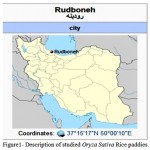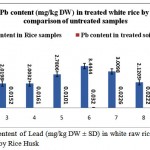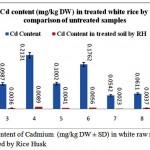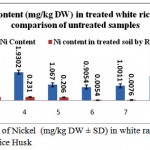How to Cite | Publication History | PlumX Article Matrix
Potential of Rice Husk Biosorption in Reduction of Heavy Metals from Oryza Sativa Rice
Fraimah Alidoost Saharkhiz Lahiji1, Parisa Ziarati2* and Afshin Jafarpour3
1Pharmaceutical Sciences Research Center, Pharmaceutical Sciences Branch, Islamic Azad University, Tehran-Iran (IAUPS).
2Department of Medicinal Chemistry, Pharmacy Faculty, Pharmaceutical Sciences Branch, Islamic Azad University (IAUPS), Tehran, Iran.
3Department of Food Sciences and Technology, Pharmaceutical Sciences Branch, Islamic Azad University, Tehran -Iran (IAUPS).
Corresponding Author E- mail: ziarati.p@iaups.ac.ir.
DOI : http://dx.doi.org/10.13005/bbra/2388
ABSTRACT: In Iran and some countries the major uses of agricultural waste are animal feed and as fuel in factories. In many cases, farmers attempted to burn these additional appearance materials which Leads to environmental pollution and in other hand reduce the fertility of the ground. To manage waste agricultural biomass and to convert it into a material resource this research was carried out. Two field experiments were carried out to evaluate rice (Oryza sativa) productivity in silt loam to which 50 Mg ha(-1) of rice husk were added as a control. The field experiment in Guilan province in the north of Iran was conducted to investigate the effect of dry rice husk on the bioavailability of heavy metals: Lead, Nickel and Cadmium in soil and their accumulation into rice plants and final rice grain product. Phytoavailability of Cd was most dramatically influenced by bio-sorbent addition. Rice husk addition in paddies 10 days before the transplanting rice stems significantly decreased Cd concentrations in rice grain (72.13 %). Following bio-sorption addition, lead and Nickel concentrations decreased by 59.53 % and 50.44% respectively and increase Potassium , Zinc , and copper in crop yield significantly( p≤ 0.03), which approve the effect of the uptake of some nutrients in the presence of rice husk. In conclusion, these results highlight the potential for dry rice husk to alleviate the phyto-accumulation of heavy and toxic metal (loid)s and to thereby reduce the toxicity and exposure associated with rice consumption.
KEYWORDS: Rice (Oryza sativa L.) ;Rice Husk; Soil contamination ; Biosorption; Agricultural waste
Download this article as:| Copy the following to cite this article: Lahiji F. A. S, Ziarati P, Jafarpour A. Potential of Rice Husk Biosorption in Reduction of Heavy Metals from Oryza Sativa Rice. Biosci Biotech Res Asia 2016;13(4). |
| Copy the following to cite this URL: Lahiji F. A. S, Ziarati P, Jafarpour A. Potential of Rice Husk Biosorption in Reduction of Heavy Metals from Oryza Sativa Rice. Biosci Biotech Res Asia 2016;13(4). Available from: https://www.biotech-asia.org/?p=17036 |
Introduction
Rapid increase in volume and types of waste agricultural biomass, as a result of intensive agriculture in the wake of population growth and improved living standards, is becoming a burgeoning problem as rotten waste agricultural biomass emits methane and leachate, and open burning by the farmers to clear the lands generate CO2 and other local pollutants. Hence improper management of waste agricultural biomass is contributing towards climate change, water and soil contamination, and local air pollution. Furthermore, this waste is of high value with respect to material and energy recovery [1]. Although there is an emerging trend on the utilization of biomass conversion technologies from combustion of rice husk and sugarcane bagasse to gasification of other agricultural residues biomass is still largely underutilized and left to rot or openly burned in the fields, especially in developing countries that do not have strong regulatory instruments to control such polluter practices. As a common practice, direct combustion of agricultural residue results in air pollution thereby posing risk to human and ecological health. Biomass is a renewable resource that causes problems when not used. The challenge, therefore, is to convert biomass as a resource for energy and other productive uses. Rice husk as a low-value agricultural by-product can be made into sorbent materials which are used in heavy metal and dye removal. It has been investigated as a replacement for currently expensive methods of heavy metal removal from solutions. Currently, the study of rice husk as a low-cost sorbent for removing heavy metals has regained attention.
Rice husks are the hard protecting coverings of grains of rice. The husk is made of hard materials, including opaline silica and lignin in order to protect the seed during the growing season. The husk is mostly indigestible to humans. During the milling process, the husks are removed from the grain to create brown rice; the brown rice is then milled further to remove the bran layer to become white rice [2,3].
Bio-sorbents are receiving increasing attention due to its benefits in agricultural and environmental contexts. There is growing evidence that the application of bio-sorbents to soil have great effect in reducing heavy metal pollution , improve soil quality [4], reduce the bioavailability of organic contaminants [5] , increase nutrient and water retention capacity of soil[6,7] and thereby increase crop yield [8].
In 2008, Iran’s total rice production stands at 2.2 million tons per annum whereas annual consumption is about three million tons [9]. Iran has imported about 630,000 tons of rice from UAE, Pakistan and Uruguay worth $271 million in 2008 and 1.4 million tons of rice, worth $800 million in 2009 [10,11] . Iran’s rice production in 2011 was 2.4 million tons, which increased from a total of 2.3 million tons in the previous year. The average per capita consumption of rice in Iran is 45.5 kg, which makes Iranians the 13th biggest rice consumers [12,13] .Rice is mostly produced in northern Iran. Rice has being cultivated for many years in Guilan Province of Iran. In Guilan Province, many indica rice cultivars including Gerdeh, Hashemi, Hasani, and Gharib have been bred by farmers [14].
Generally, farmers and rice processor often burn the rice husk as wastes, and this which releases carbon dioxide (CO2) into the atmosphere. CO2 is a well-known greenhouse gas. Research on fully utilize the agriculture waste means to avoid burning the rice husks as wastes are worth like. Rice husk is a very cost-effective raw material to be used and it is very easy to obtain. In Iran and some countries the major uses of agricultural waste are, animal feed and as fuel in factories. In many cases, farmers attempted to burn these additional appearance materials which leads to environmental pollution and in other hand reduce the fertility of the ground. To manage waste agricultural biomass and to convert it into a material resource this research was carried out. The current study deals with the utilization of rice husk as agricultural and food waste materials as bio-sorbents for removal of toxic heavy metal ions: Nickel, Cadmium and Lead from studied Oryza Sativa rice cultivated in Rudboneh paddies in Guilan province the north of Iran.
Material and Method
Bio-sorbent and Study Area
The field experiment was carried out at two rice field in Rudboneh city (each one more than 15 hectares), in Lahijan County, Guilan Province in the north of Iran ( 37°15′17″N 50°00′10″E) and was initiated in 2016. Gilan Province is one of the 31 provinces of Iran. It lies along the Caspian Sea, just west of the province of Mazandaran, east of the province of Ardabil, north of the provinces of Zanjan and Qazvin [15]. This area has an average annual precipitation of 1,369 mm, air temperature of 15.9°C, and relative humidity of 81%.The name and description of all the sites in this study are provided in figure 1.
 |
Figure 1: Description of studied Oryza Sativa Rice paddies. |
Rice husk ( RH (was obtained from two rice mills in the north of Iran from the rice paddies in the same location of study and they were approximately 2-4 cm pieces and the characteristics of studied rice husk are mentioned in table 1 . The soil samples from all parts of paddy fields with textures of silty clay, silty clay loam, clay loam, and sandy loam were air dried and crushed. Each soil was studied and the soil characteristic was shown in table 2.
The originally native rice paddies area was used for years under conventional management, and the soil was sampled twice (15 and 210 days after incorporating RH). In this study two paddy field areas from Guilan those had different textures or different particle size distribution and bulk density were chosen. Two field experiments were carried out to evaluate rice (Oryza sativa) productivity in mostly silt loam to which 50 Mg ha(-1) of rice husk were added as a control.
Table 1: Characterization of studied Rice Husk
| Elements Analyzed | Si (mg/kg) | Ca (mg/Kg) | K (mg/Kg) | Mg (mg/kg) | Water (%) | pH | Ash (%) |
| 105 | 110 | 9659 | 179 | 10.2 | 6.52 | 13.23 |
Table 2: Particle Size, texture, organic matter content, FC and PWP of the studied soils.
| Soil texture | Sand (%) | Silt (%) | Clay(%) | Organic matter (%) | PWP(%W) | FC(%W) |
| Silty clay | 8 | 42 | 50 | 1.48 | 23.7 | 45 |
| Silty clay loam | 14 | 44 | 40 | 1.92 | 24.5 | 38 |
| Sandy loam | 73 | 11 | 10 | 0.31 | 6.1 | 12 |
Experiment
Nickel, Lead and Cadmium concentrations in treated rice by rice husk and conventional rice products were determined by wet digestion method and using 2 g of each rice sample and 12 ml concentrated nitric acid ( 65% Merck) and 4
ml of Hydrochloric Acid ( 36.5%, Merck) was added and placed on a hot plate with gradual heat increase to insure full digestion and the disappearance of any residual and nickel, lead and cadmium contents were determined by using flame atomic absorption spectrophotometer (FAAS). Standardized international protocols were followed for the preparation of material and analysis of heavy metals contents by wet digestion method and atomic absorption spectrophotometer analysis based on annual book of ASTM standards and AOAC [16-18]. All digested sample flasks were firstly heated slowly and then vigorously till a white residue is obtained. The residue was dissolved and made up to 10 ml with 0.1 N HNO3 in a volumetric flask. All glassware and plastic containers used were washed with liquid soap, rinsed with water, soaked in 10% volume/volume nitric acid for 24hrs, cleaned thoroughly with distilled water and dried in such a manner to ensure that any contamination does not occur. Blanks and samples were also processed and analyzed simultaneously. All the chemicals used were of Analytical Grade (AR). For heavy metal analyses 5 gram of each rice sample in different states and stages of cooking method was weighed on electronic balance (Shimadzu LIBROR AEX 200G). The samples were analyzed according to standardized international protocols by wet digestion method, Using HNO3 and HCl , analyzed by a Flame Emission Spectrophotometer Model AA-6200 (Shimadzu, Japan) using an air-acetylene flame for heavy metals in research Analytical Laboratory in Pharmaceutical Sciences Branch , Islamic Azad University, using six standard solutions for each metal. All necessary precautions were taken to avoid any possible contamination of the sample as per the AOAC guidelines [16-18].
Bio-removal Nickel, Cadmium and Lead from Rice Samples
According to the results of all experiments applied above, current investigation was designed to examine the capacity of rice husk for the bio-removal of Nickel, cadmium and lead ions from contaminated soil of paddy rice samples after the determination of these metals in such rice samples in different states. In this experiment, 50 Mg ha (-1) of rice husk were added as a control and rice crops after milling as white grain rice products ready for consumption were studied in both groups of survey: treated by RH and conventional rice .
Risk Assessment
To evaluate the potential risk of rice consumption containing the heavy metals, Provisional Tolerable Daily Intake (PTDI) for a 60kg adult person was calculated by the following equation in which C is the heavy metal concentration in rice, Cons is the average consumption of rice in country (110g per capita per day) and BW is body weight of an Iranian adult person (60kg). The output was compared with the WHO/FAO and Iranian standard level.
PTDI = C × Cons BW
The Iran standard PTDI limits have been recommended for, Cd, Pb and As 0.001, 0.0036 and 0.0021mg/day/kg BW, respectively [19,20].
Statistical analysis
The values reported here are means of five values. Data were tested at different significant levels using student t-test to measure the variations between the concentrations of heavy metals with and without treated by rice husk adsorbent. One way analysis of variance (One-ANOVA) was used for data analysis to measure the variations of heavy metal concentrations using SPSS 22.0 software (SPSS Inc, IBM, Chicago, IL).
Results and Discussion
The mean level of heavy metals was determined in a laboratory scale using 10 samples. All samples were analyzed three times. To clarify the status of the obtained concentration values better, the maximum allowable contents of metals in rice, we referred to the joint FAO/WHO and national standard. Expert Committee on Food Additives (JECFA) has proposed a maximum level of 0.2 mg/kg Cadmium in rice but the community warned that “people who eat a lot of rice from regions containing the higher levels of cadmium could be significantly exposed [19-20].
Iran Standard (No. 12968) has established the maximum limit of Cd in rice about 0.06 mg/kg and on the whole Institute of Standard and Industrial Research of Iran set limit of 0.15 mg/ kg as the maximum level for lead and arsenic and 0.06 mg/kg for cadmium in rice (Organization INS. Food & feed-maximum limit of heavy metals, in 2013[19] . Although the concentration of Pb and Cd varied among the samples, 72% of the untreated rice samples contained lower limit than the upper level of 0.15 and 0.06 mg/kg recommended by Iran Standard.
 |
Figure 2: The mean content of Lead (mg/kg DW ± SD) in white raw rice samples untreated in comparison of treated by Rice Husk |
The physical appearance of untreated white raw rice and treated samples by Rh in the paddies was seen in figures 2,3 and 4. After pretreatment in the contaminated soil of paddies , it was seen to be detoxified rice samples from Lead in figure 2 . Our data revealed that mean Pb concentration in studied paddies which treated by RH significantely decreased ( p ≤ 0.003 ) . The mean level of lead ( mg/kg DW) for all studied rice samples in studied paddies without treatment was 2.4038 ± 0.005( mg/kg DW) but for studied smples from paddies by RH which treated 10 days before the transplanting rice stems decreased to 0.0136 ± 0.002( mg/kg DW).
 |
Figure 3: The mean content of Cadmium (mg/kg DW ± SD) in white raw rice samples untreated in comparison of treated by Rice Husk |
Phytoavailability of Cd was most dramatically influenced by bio-sorbent addition. Cd content in 83.4% conventional samples from paddies in Rudboneh was higher than maximum permissible level set by Iranian National Standardization Organization( 2013 ) but in treated soil paddies all samples was lower than permissible level ( figure 3). Rice husk addition in paddies 10 days before the transplanting rice stems significantly decreased Cd concentrations in rice grain (72.13 %) and as it is shown in figure 3, the mean contents of cadmium in all contaminated white rice samples in comparison of treated samples are much higher and applying RH decreased Cadmium significantly (( p ≤ 0.005 ).
 |
Figure 4: The mean content of Nickel (mg/kg DW ± SD) in white raw rice samples untreated in comparison of treated by Rice Husk |
ANOVA analysis showed that there was a significant difference in Ni and Pb contents in conventional farms samples and white rice from treated paddies’ soil samples (p < 0.003 and p < 0.005 respectively). There were no permitted values available for the other heavy metals such as Nickel to be compared with those of the rice sample contents. The permissible limit of Nickel in plants recommended by WHO is 10mg/k [20] .Nickel has been considered to be an essential trace element for human and animal health. In living systems, it is associated with DNA and RNA molecules and also a regulatory element for the various enzyme systems [20-21].
Conclusion
In consideration with its low cost and easy availability, application of RH is still limited and there is tremendous potential of this material for use in upcoming industrial processing and technology. Utilization of rice husk could solve the disposal problem and reduce the cost of waste treatment. Rice Husk and its ash are used directly for manufacturing and synthesizing new materials. It is used as a fuel, fertilizer, substrate and it also used in preparation of activated carbon, Pet food fiber, Silica and silicon compounds, bricks etc. Rice husk ash used in steel, cement and construction industries. Rice Husk act as an adsorbent for heavy metal removal from soil of farmlands and rice paddies and consequences in food stuff. Easy availability and low price of rice husk in rice producing countries like Iran is an extra benefit towards the use of this material. Multiple benefits of rice husk and similar agricultural waste materials can be achieved by future critical research efforts to provide new impetus for local and regional sustainable development. The current study revealed that the application of rice husk increased Si, P and K in the grain of rice product, but did not result in an excessive uptake of heavy metals in the submerged paddy soil. In conclusion, rice husk could be a good supplement to other inorganic soil amendments to improve the nutrient balance in paddy soils.
Conflict of Interest
The authors have no affiliations, memberships, funding, or financial holdings that might be perceived as affecting the objectivity of this publication.
Acknowledgment
Authors are thankful to Mrs. Mahtab Alimardan for her technical assistance. Financial Supports from Pharmaceutical Sciences Branch, Islamic Azad University (IAUPS) is gratefully acknowledged.
References
- United Nations Environmental Programme Division of Technology, Industry and Economics International Environmental Technology Centre Osaka/Shiga, Japan.2012. Available on Site: http://www.unep.org/ietc/Portals/136/Publications/Waste%20Management.
- Noor-Syuhadah, S., Rohasliney, H. Rice Husk as Biosorbent: A Review. Health and the Environment Journal, 2012; 3( 1) :89-95.
- Akhtar, M., Bhanger, M. I., Iqbal, S. and Hasany, S.MSorption potential of rice husk for the removal of 2,4-dichlorophenol from aqueous solutions: Kinetic and thermodynamic investigations. Journal of HazardousMaterials ., 2006; 128(1): 44-52.
CrossRef - Mahmoud, E., Kader, N. A. E., Robin, P., Corfini, N. A. and Rahman, L. A. E. Effects of Different Organic and Inorganic Fertilizers on Cucumber Yield and Some Soil Properties. World J. Agricult. Sci., 2009; 5: 408-14.
- Li, L., Zheng, C., Fu, Y.,Wu, D., Yang,X., Shen, H., Silicate-mediated alleviation of Pb toxicity in banana grown in Pb-contaminated soil. Biol. Trace Elem. Res. 2012; 145: 101–8.
CrossRef - Abel, S., Peters, A., Trinks, S., Schonsky, H., Facklam, M., Wessolek, G. Impact of biochar and hydrochar addition on water retention and water repellency of sandy soil. Geoderma ,2013; 202:183–91.
CrossRef - Zheng, H., Wang, Z., Deng, X., Herbert, S., Xing, B. Impacts of adding biochar on nitrogen retention and bioavailability in agricultural soil. Geoderma., 2013 ;206: 32–9.
CrossRef - Zhang, A.F., Cui, L.Q., Pan ,G.X., Li, L.Q., Hussain, Q., Zhang, X.H., Zheng, J.W., Crowley, D. Effect of biochar amendment on yield and methane and nitrous oxide emissions from a rice paddy from Tai Lake plain, China. Agric Ecosyst Environ .,2010; 139:469–75.
CrossRef - Available on Site: http://www.iranicaonline.org/articles/agriculture-in-iran
- Available on Site : https://web.archive.org/web/20090130115513/http://irandaily.com:80/1387/3273/html/economy.htm.
- Available on Site: https://web.archive.org/web/20090918192250/http://www.irandaily.com:80/1388/3473/html/economy.htm.
- Available on Site: https://web.archive.org/20090619234524.
- Available on Site: http://www.iran-daily.Com./80/1388/3373 /html/economy.htm .
- Pazuki,A., SOHANI, M.M. Phenotypic evaluation of scutellum-derived calluses in ‘Indica’ rice cultivars. Acta agriculturae Slovenica, 2013;101 – 2: 239 –47.
- 1998. AOAC (Association of Official Analytical Chemists). Wet digestion for non–volatile metals in: AOAC official methods of analysis 1998 , 16th edition, 4th revision, vol.1,chapter 9.
- ASTM .2000. Annual Book of ASTM standards, water and Environmental technology. Standard Guide for preparation of Biological samples for inorganic chemical Analysis, 2000; 11.01 ;4638-95 .
- O.A.C. 2000. Official method of analysis 17th edition, Horowitz edition intern, Maryland, USA. 1: 452-6.
- Iranian National Standardization Organization; 2013. Available from: http://isiri.org/portal/File/ShowFile.asp .
- Permissible limits of heavy metals in soil and plants, (Genava: World Health Organization), Switzerland (1996).
- Roux, J. C. The evolution of ground water quality in france: Perspectives for enduring use to catchments in Mid – Wales. Journal of Hydrology, 1995;116: 3-16 .

This work is licensed under a Creative Commons Attribution 4.0 International License.





